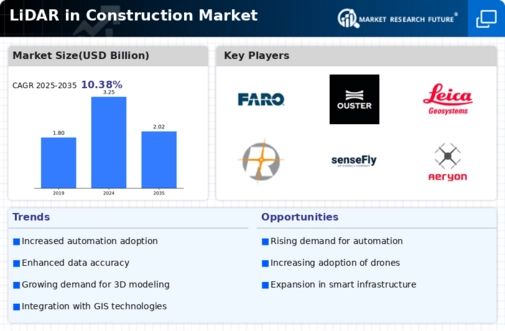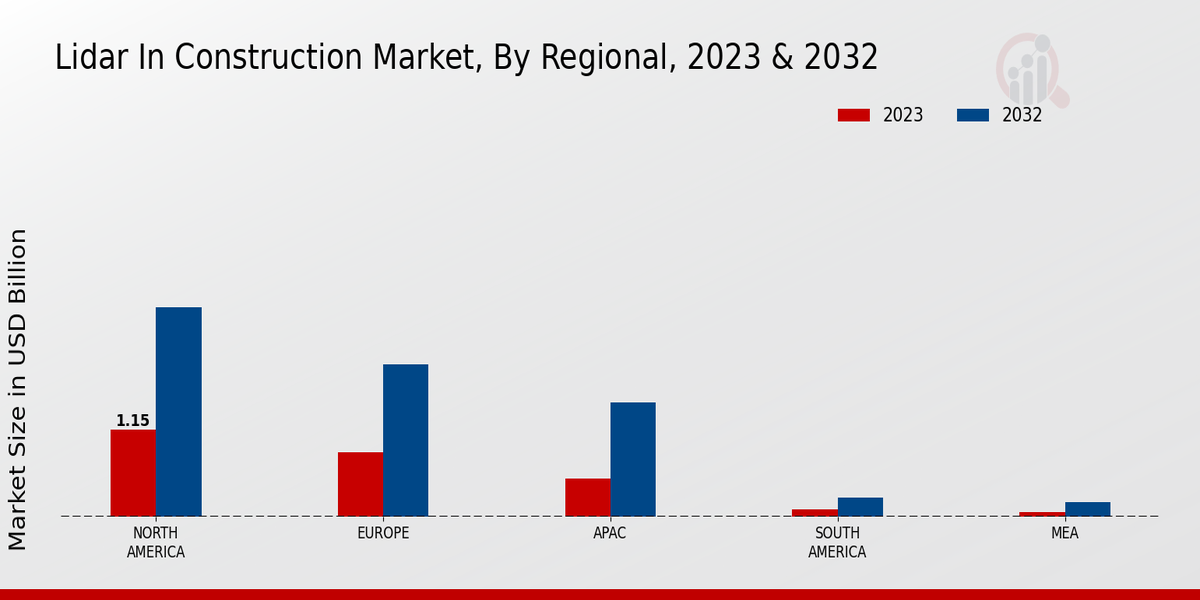Regulatory Compliance
Regulatory compliance is a critical driver in the Global LiDAR in Construction Market Industry, as governments worldwide implement stricter building codes and environmental regulations. LiDAR technology facilitates compliance by providing precise measurements and detailed topographical data, which are essential for obtaining necessary permits and approvals. For example, in regions with stringent environmental assessments, LiDAR can help identify potential impacts on ecosystems, thereby streamlining the approval process. As the market evolves, the need for compliance with these regulations is likely to sustain demand for LiDAR solutions, further solidifying its role in modern construction practices.
Technological Advancements
The Global LiDAR in Construction Market Industry is experiencing rapid technological advancements that enhance data accuracy and processing speed. Innovations in sensor technology and software integration have led to more efficient workflows, allowing construction professionals to capture detailed site information quickly. For instance, the integration of artificial intelligence with LiDAR systems enables real-time data analysis, which can significantly reduce project timelines. As of 2024, the market is valued at approximately 3.25 USD Billion, indicating a robust demand for these advanced technologies. This trend suggests that construction firms are increasingly adopting LiDAR solutions to improve project outcomes and reduce costs.
Growing Demand for 3D Mapping
The growing demand for 3D mapping solutions is a significant driver in the Global LiDAR in Construction Market Industry. As construction projects become increasingly complex, the need for accurate and detailed 3D models has surged. LiDAR technology provides high-resolution 3D mapping capabilities that enable architects and engineers to visualize projects more effectively. This demand is particularly evident in urban planning and heritage conservation, where precise measurements are crucial. The market's projected decline to 2.02 USD Billion by 2035, with a CAGR of -4.24% for 2025-2035, suggests that while growth may slow, the need for 3D mapping will remain a key focus area for construction professionals.
Market Trends and Projections
The Global LiDAR in Construction Market Industry is characterized by evolving trends and projections that reflect its dynamic nature. The market is currently valued at 3.25 USD Billion in 2024, with expectations of a decline to 2.02 USD Billion by 2035. This decline corresponds with a projected CAGR of -4.24% for the period from 2025 to 2035. Such trends may indicate a maturation of the market, where initial rapid growth stabilizes as technology becomes more mainstream. Understanding these trends is crucial for stakeholders aiming to navigate the complexities of the LiDAR landscape in construction.
Labor Shortages and Efficiency Needs
Labor shortages in the construction industry are prompting firms to seek innovative solutions to enhance efficiency, positioning the Global LiDAR in Construction Market Industry favorably. As skilled labor becomes increasingly scarce, companies are turning to LiDAR technology to automate processes such as surveying and site analysis. This shift not only mitigates the impact of labor shortages but also improves overall project efficiency and accuracy. The ability of LiDAR to quickly gather and process data allows construction teams to allocate resources more effectively, thereby addressing labor challenges. This trend indicates a growing reliance on technology to compensate for workforce limitations.
Increased Investment in Infrastructure
The Global LiDAR in Construction Market Industry is bolstered by increased investment in infrastructure projects across various regions. Governments are allocating substantial budgets for the development and maintenance of transportation networks, utilities, and urban development. This surge in infrastructure spending creates a favorable environment for LiDAR technology adoption, as it offers precise mapping and modeling capabilities essential for large-scale projects. The projected market value of 3.25 USD Billion in 2024 reflects this trend, as construction firms seek to leverage LiDAR for enhanced project planning and execution. The long-term outlook remains positive, with infrastructure investments likely to drive sustained growth.












